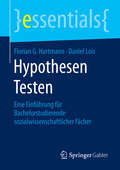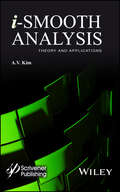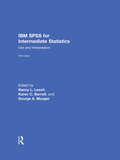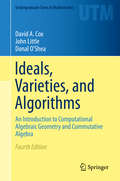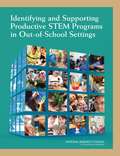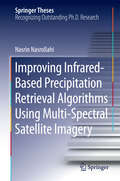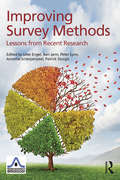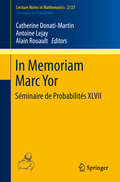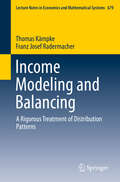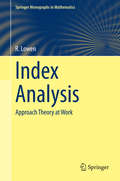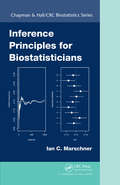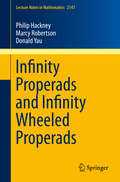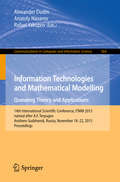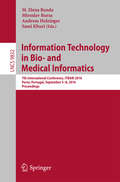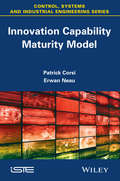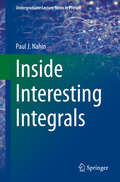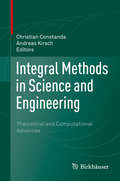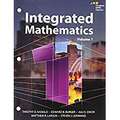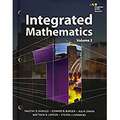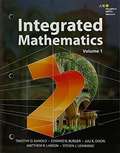- Table View
- List View
Hypothesen Testen: Eine Einführung für Bachelorstudierende sozialwissenschaftlicher Fächer (essentials)
by Florian G. Hartmann Daniel LoisDie Sozialwissenschaftler Florian G. Hartmann und Daniel Lois erklären in diesem Essential Schritt für Schritt und auf Nachvollziehbarkeit bedacht, wie im Rahmen einer quantitativen Untersuchung Hypothesen überprüft werden. Dabei werden methodische und statistische Grundbegriffe besprochen und komplexere Sachverhalte anhand von alltagsnahen Beispielen erläutert. Die Autoren schöpfen bei den Erklärungen aus ihrer Lehr- und Forschungstätigkeit und berücksichtigen die Erfahrungen ihres eigenen Studiums.
“I Don’t See Color”: Personal and Critical Perspectives on White Privilege
by Bettina Bergo Eula Biss Tracey NichollsWho is white, and why should we care? There was a time when the immigrants of New York City’s Lower East Side—the Irish, the Poles, the Italians, the Russian Jews—were not white, but now “they” are. There was a time when the French-speaking working classes of Quebec were told to “speak white,” that is, to speak English. Whiteness is an allegorical category before it is demographic.This volume gathers together some of the most influential scholars of privilege and marginalization in philosophy, sociology, economics, psychology, literature, and history to examine the idea of whiteness. Drawing from their diverse racial backgrounds and national origins, these scholars weave their theoretical insights into essays critically informed by personal narrative. This approach, known as “braided narrative,” animates the work of award-winning author Eula Biss. Moved by Biss’s fresh and incisive analysis, the editors have assembled some of the most creative voices in this dialogue, coming together across the disciplines. Along with the editors, the contributors are Eduardo Bonilla-Silva, Nyla R. Branscombe, Drucilla Cornell, Lewis R. Gordon, Paget Henry, Ernest-Marie Mbonda, Peggy McIntosh, Mark McMorris, Marilyn Nissim-Sabat, Victor Ray, Lilia Moritz Schwarcz, Louise Seamster, Tracie L. Stewart, George Yancy, and Heidi A. Zetzer.
i-Smooth Analysis: Theory and Applications
by A. V. KimThe edition introduces a new class of invariant derivatives and shows their relationships with other derivatives, such as the Sobolev generalized derivative and the generalized derivative of the distribution theory. This is a new direction in mathematics. i-Smooth analysis is the branch of functional analysis that considers the theory and applications of the invariant derivatives of functions and functionals. The important direction of i-smooth analysis is the investigation of the relation of invariant derivatives with the Sobolev generalized derivative and the generalized derivative of distribution theory. Until now, i-smooth analysis has been developed mainly to apply to the theory of functional differential equations, and the goal of this book is to present i-smooth analysis as a branch of functional analysis. The notion of the invariant derivative (i-derivative) of nonlinear functionals has been introduced in mathematics, and this in turn developed the corresponding i-smooth calculus of functionals and showed that for linear continuous functionals the invariant derivative coincides with the generalized derivative of the distribution theory. This book intends to introduce this theory to the general mathematics, engineering, and physicist communities.
IBM SPSS for Intermediate Statistics: Use and Interpretation, Fifth Edition
by George A. Morgan Nancy L. Leech Karen C. BarrettDesigned to help readers analyze and interpret research data using IBM SPSS, this user-friendly book shows readers how to choose the appropriate statistic based on the design; perform intermediate statistics, including multivariate statistics; interpret output; and write about the results. The book reviews research designs and how to assess the accuracy and reliability of data; how to determine whether data meet the assumptions of statistical tests; how to calculate and interpret effect sizes for intermediate statistics, including odds ratios for logistic analysis; how to compute and interpret post-hoc power; and an overview of basic statistics for those who need a review. Unique chapters on multilevel linear modeling; multivariate analysis of variance (MANOVA); assessing reliability of data; multiple imputation; mediation, moderation, and canonical correlation; and factor analysis are provided. SPSS syntax with output is included for those who prefer this format. The new edition features: * IBM SPSS version 22; although the book can be used with most older and newer versions * New discusiion of intraclass correlations (Ch. 3) * Expanded discussion of effect sizes that includes confidence intervals of effect sizes (ch.5) * New information on part and partial correlations and how they are interpreted and a new discussion on backward elimination, another useful multiple regression method (Ch. 6) * New chapter on how to use a variable as a mediator or a moderator (ch. 7) * Revised chapter on multilevel and hierarchical linear modeling (ch. 12) * A new chapter (ch. 13) on multiple imputation that demonstrates how to deal with missing data * Updated web resources for instructors including PowerPoint slides and answers to interpretation questions and extra problems and for students, data sets, chapter outlines, and study guides. IBM SPSS for Intermediate Statistics, Fifth Edition provides helpful teaching tools: * all of the key SPSS windows needed to perform the analyses * outputs with call-out boxes to highlight key points * interpretation sections and questions to help students better understand and interpret the output * extra problems with realistic data sets for practice using intermediate statistics * Appendices on how to get started with SPSS, write research questions, and basic statistics. An ideal supplement for courses in either intermediate/advanced statistics or research methods taught in departments of psychology, education, and other social, behavioral, and health sciences. This book is also appreciated by researchers in these areas looking for a handy reference for SPSS
Ideals, Varieties, and Algorithms: An Introduction to Computational Algebraic Geometry and Commutative Algebra (Undergraduate Texts in Mathematics)
by David A. Cox John Little Donal O'SheaThis text covers topics in algebraic geometry and commutative algebra with a strong perspective toward practical and computational aspects. The first four chapters form the core of the book. A comprehensive chart in the Preface illustrates a variety of ways to proceed with the material once these chapters are covered. In addition to the fundamentals of algebraic geometry--the elimination theorem, the extension theorem, the closure theorem and the Nullstellensatz--this new edition incorporates several substantial changes, all of which are listed in the Preface. The largest revision incorporates a new Chapter (ten), which presents some of the essentials of progress made over the last decades in computing Gröbner bases. The book also includes current computer algebra material in Appendix C and updated independent projects (Appendix D). The book may serve as a first or second course in undergraduate abstract algebra and with some supplementation perhaps, for beginning graduate level courses in algebraic geometry or computational algebra. Prerequisites for the reader include linear algebra and a proof-oriented course. It is assumed that the reader has access to a computer algebra system. Appendix C describes features of Maple(tm), Mathematica® and Sage, as well as other systems that are most relevant to the text. Pseudocode is used in the text; Appendix B carefully describes the pseudocode used. From the reviews of previous editions: ". . . The book gives an introduction to Buchberger's algorithm with applications to syzygies, Hilbert polynomials, primary decompositions. There is an introduction to classical algebraic geometry with applications to the ideal membership problem, solving polynomial equations and elimination theory. . . . The book is well-written. . . . The reviewer is sure that it will be an excellent guide to introduce further undergraduates in the algorithmic aspect of commutative algebra and algebraic geometry. " --Peter Schenzel, zbMATH, 2007 "I consider the book to be wonderful. . . . The exposition is very clear, there are many helpful pictures and there are a great many instructive exercises, some quite challenging . . . offers the heart and soul of modern commutative and algebraic geometry. " --The American Mathematical Monthly
Identifying and Supporting Productive STEM Programs in Out-of-School Settings
by Committee on Successful Out-of-School STEM LearningMore and more young people are learning about science, technology, engineering, and mathematics (STEM) in a wide variety of afterschool, summer, and informal programs. At the same time, there has been increasing awareness of the value of such programs in sparking, sustaining, and extending interest in and understanding of STEM. To help policy makers, funders and education leaders in both school and out-of-school settings make informed decisions about how to best leverage the educational and learning resources in their community, this report identifies features of productive STEM programs in out-of-school settings. "Identifying and Supporting Productive STEM Programs in Out-of-School Settings" draws from a wide range of research traditions to illustrate that interest in STEM and deep STEM learning develop across time and settings. The report provides guidance on how to evaluate and sustain programs. This report is a resource for local, state, and federal policy makers seeking to broaden access to multiple, high-quality STEM learning opportunities in their community.
Improving Infrared-Based Precipitation Retrieval Algorithms Using Multi-Spectral Satellite Imagery
by Nasrin NasrollahiThis thesis transforms satellite precipitation estimation through the integration of a multi-sensor, multi-channel approach to current precipitation estimation algorithms, and provides more accurate readings of precipitation data from space. Using satellite data to estimate precipitation from space overcomes the limitation of ground-based observations in terms of availability over remote areas and oceans as well as spatial coverage. However, the accuracy of satellite-based estimates still need to be improved. The approach introduced in this thesis takes advantage of the recent NASA satellites in observing clouds and precipitation. In addition, machine-learning techniques are also employed to make the best use of remotely-sensed "big data. " The results provide a significant improvement in detecting non-precipitating areas and reducing false identification of precipitation.
Improving Survey Methods: Lessons from Recent Research (European Association of Methodology Series)
by Uwe Engel Ben Jann Peter Lynn Annette Scherpenzeel Patrick SturgisThis state-of-the-art volume provides insight into the recent developments in survey research. It covers topics like: survey modes and response effects, bio indicators and paradata, interviewer and survey error, mixed-mode panels, sensitive questions, conducting web surveys and access panels, coping with non-response, and handling missing data. The authors are leading scientists in the field, and discuss the latest methods and challenges with respect to these topics. Each of the book’s eight parts starts with a brief chapter that provides an historical context along with an overview of today’s most critical survey methods. Chapters in the sections focus on research applications in practice and discuss results from field studies. As such, the book will help researchers design surveys according to today’s best practices. The book’s website www.survey-methodology.de provides additional information, statistical analyses, tables and figures. An indispensable reference for practicing researchers and methodologists or any professional who uses surveys in their work, this book also serves as a supplement for graduate or upper level-undergraduate courses on survey methods taught in psychology, sociology, education, economics, and business. Although the book focuses on European findings, all of the research is discussed with reference to the entire survey-methodology area, including the US. As such, the insights in this book will apply to surveys conducted around the world.
In Memoriam Marc Yor - Séminaire de Probabilités XLVII
by Catherine Donati-Martin Antoine Lejay Alain RouaultThis volume is dedicated to the memory of Marc Yor, who passed away in 2014. The invited contributions by his collaborators and former students bear testament to the value and diversity of his work and of his research focus, which covered broad areas of probability theory. The volume also provides personal recollections about him, and an article on his essential role concerning the Doeblin documents. With contributions by P. Salminen, J-Y. Yen & M. Yor; J. Warren; T. Funaki; J. Pitman& W. Tang; J-F. Le Gall; L. Alili, P. Graczyk & T. Zak; K. Yano & Y. Yano; D. Bakry & O. Zribi; A. Aksamit, T. Choulli & M. Jeanblanc; J. Pitman; J. Obloj, P. Spoida & N. Touzi; P. Biane; J. Najnudel; P. Fitzsimmons, Y. Le Jan & J. Rosen; L. C. G. Rogers & M. Duembgen; E. Azmoodeh, G. Peccati & G. Poly, timP-L Méliot, A. Nikeghbali; P. Baldi; N. Demni, A. Rouault & M. Zani; N. O'Connell; N. Ikeda & H. Matsumoto; A. Comtet & Y. Tourigny; P. Bougerol; L. Chaumont; L. Devroye & G. Letac; D. Stroock and M. Emery.
Income Modeling and Balancing
by Thomas Kämpke Franz Josef RadermacherThis book presents a rigorous treatment of the mathematical instruments available for dealing with income distributions, in particular Lorenz curves and related methods. The methods examined allow us to analyze, compare and modify such distributions from an economic and social perspective. Though balanced income distributions are key to peaceful coexistence within and between nations, it is often difficult to identify the right kind of balance needed, because there is an interesting interaction with innovation and economic growth. The issue of justice, as discussed in Thomas Piketty's bestseller "Capital in the Twenty-First Century" or in the important book "The Price of Inequality" by Nobel laureate Joseph Stiglitz, is also touched on. Further, there is a close connection to the issue of democracy in the context of globalization. One highlight of the book is its rigorous treatment of the so-called Atkinson theorem and some extensions, which help to explain under which type of societal utility functions nations tend to operate either in the direction of more balance or less balance. Finally, there are some completely new insights into changing the balance pattern of societies and the kind of coalitions between richer and poorer parts of society to organize political support in democracies in either case. Oxford University's Sir Tony Atkinson, well known for his so-called Atkinson theorem, writes in his foreword to the book: "[The authors] contribute directly to t he recent debates that are going on in politics. [. . . ] with this book the foundation of arguments concerning a proper balance in income distribution in the sense of identifying an 'efficient inequality range' has got an additional push from mathematics, which I appreciate very much. "
Index Analysis
by R. LowenThe featured review of the AMS describes the author's earlier work in the field of approach spaces as, 'A landmark in the history of general topology'. In this book, the author has expanded this study further and taken it in a new and exciting direction. The number of conceptually and technically different systems which characterize approach spaces is increased and moreover their uniform counterpart, uniform gauge spaces, is put into the picture. An extensive study of completions, both for approach spaces and for uniform gauge spaces, as well as compactifications for approach spaces is performed. A paradigm shift is created by the new concept of index analysis. Making use of the rich intrinsic quantitative information present in approach structures, a technique is developed whereby indices are defined that measure the extent to which properties hold, and theorems become inequalities involving indices; therefore vastly extending the realm of applicability of many classical results. The theory is then illustrated in such varied fields as topology, functional analysis, probability theory, hyperspace theory and domain theory. Finally a comprehensive analysis is made concerning the categorical aspects of the theory and its links with other topological categories. Index Analysis will be useful for mathematicians working in category theory, topology, probability and statistics, functional analysis, and theoretical computer science.
The Indo-European Controversy
by Pereltsvaig, Asya and Lewis, Martin W. Asya Pereltsvaig Martin W. LewisOver the past decade, a group of prolific and innovative evolutionary biologists has sought to reinvent historical linguistics through the use of phylogenetic and phylogeographical analysis, treating cognates like genes and conceptualizing the spread of languages in terms of the diffusion of viruses. Using these techniques, researchers claim to have located the origin of the Indo-European language family in Neolithic Anatolia, challenging the near-consensus view that it emerged in the grasslands north of the Black Sea thousands of years later. But despite its widespread celebration in the global media, this new approach fails to withstand scrutiny. As languages do not evolve like biological species and do not spread like viruses, the model produces incoherent results, contradicted by the empirical record at every turn. This book asserts that the origin and spread of languages must be examined primarily through the time-tested techniques of linguistic analysis, rather than those of evolutionary biology.
Inequalities for Graph Eigenvalues
by Zoran StaniWritten for mathematicians working with the theory of graph spectra, this book explores more than 400 inequalities for eigenvalues of the six matrices associated with finite simple graphs: the adjacency matrix, Laplacian matrix, signless Laplacian matrix, normalized Laplacian matrix, Seidel matrix, and distance matrix. The book begins with a brief survey of the main results and selected applications to related topics, including chemistry, physics, biology, computer science, and control theory. The author then proceeds to detail proofs, discussions, comparisons, examples, and exercises. Each chapter ends with a brief survey of further results. The author also points to open problems and gives ideas for further reading.
Inference Principles for Biostatisticians (Chapman & Hall/CRC Biostatistics Series)
by Ian C. MarschnerDesigned for students training to become biostatisticians as well as practicing biostatisticians, Inference Principles for Biostatisticians presents the theoretical and conceptual foundations of biostatistics. It covers the theoretical underpinnings essential to understanding subsequent core methodologies in the field.Drawing on his extensive exper
Infinity Properads and Infinity Wheeled Properads
by Philip Hackney Marcy Robertson Donald YauThe topic of this book sits at the interface of the theory of higher categories (in the guise of (∞,1)-categories) and the theory of properads. Properads are devices more general than operads and enable one to encode bialgebraic, rather than just (co)algebraic, structures. The text extends both the Joyal-Lurie approach to higher categories and the Cisinski-Moerdijk-Weiss approach to higher operads, and provides a foundation for a broad study of the homotopy theory of properads. This work also serves as a complete guide to the generalised graphs which are pervasive in the study of operads and properads. A preliminary list of potential applications and extensions comprises the final chapter. Infinity Properads and Infinity Wheeled Properads is written for mathematicians in the fields of topology, algebra, category theory, and related areas. It is written roughly at the second year graduate level, and assumes a basic knowledge of category theory.
Information Technologies and Mathematical Modelling - Queueing Theory and Applications
by Rafael Yakupov Anatoly Nazarov Alexander DudinThisbook constitutes the refereed proceedings fo the 14th International Scientific Conferenceon Information Technologies and Mathematical Modeling, named after A. F. Terpugov, ITMM 2015, held in Anzhero-Sudzhensk, Russia, in November 2015. The 35 full papers included in this volume were carefully reviewedand selected from 89 submissions. They are devoted to new results in thequeueing theory and its applications, addressing specialists in probabilitytheory, random processes, mathematical modeling as well as engineers dealingwith logical and technical design and operational management oftelecommunication and computer networks.
Information Technology in Bio- and Medical Informatics
by Sami Khuri Andreas Holzinger Miroslav Bursa M. Elena RendaThis book constitutes the refereed proceedings of the 6th International Conference on Information Technology in Bio- and Medical Informatics, ITBAM 2015, held in Valencia, Spain, in September 2015, in conjunction with DEXA 2015. The 9 revised long papers presented together with 1 poster paper were carefully reviewed and selected from 15 submissions. The papers address the following two topics: medical terminology and clinical processes and machine learning in biomedicine.
Innovation Capability Maturity Model
by Patrick Corsi Erwan NeauWhilst innovation remains of course an approach, a process, and is still often even reduced to a set of results, it essentially reflects a way of thinking evolution. Time is up for varying the thinking methods according to capacities and learned and available competencies with a view to change. . . the thinking level. No domain and no sector is immune to this transformation in todays' world Having clarified our ideas through this book, we remain ever more convinced that the leveled maturity approach will lead to real advances in innovation over the 2020 years. Hence the competitive capacities of organizations must evolve. As we strive in our quest for new inspiration sources in business, let us reckon that all is bound to evolving. . . including the way to evolve. In that resides the very capacity to innovate.
Inside Interesting Integrals
by Paul J. NahinWhat's the point of calculating definite integrals since you can't possibly do them all?. What makes doing the specific integrals in this book of value aren't the specific answers we'll obtain, but rather the methods we'll use in obtaining those answers; methods you can use for evaluating the integrals you will encounter in the future. This book is written in a light-hearted manner for students who have completed the first year of college or high school AP calculus and have just a bit of exposure to the concept of a differential equation. Every result is fully derived. If you are fascinated by definite integrals, then this is a book for you.
Integral Methods in Science and Engineering
by Christian Constanda Andreas KirschThis contributed volume contains a collection of articles on state-of-the-art developments on the construction of theoretical integral techniques and their application to specific problems in science and engineering. Written by internationally recognized researchers, the chapters in this book are based on talks given at the Thirteenth International Conference on Integral Methods in Science and Engineering, held July 21-25, 2014, in Karlsruhe, Germany. A broad range of topics is addressed, from problems of existence and uniqueness for singular integral equations on domain boundaries to numerical integration via finite and boundary elements, conservation laws, hybrid methods, and other quadrature-related approaches. This collection will be of interest to researchers in applied mathematics, physics, and mechanical and electrical engineering, as well as graduate students in these disciplines and other professionals for whom integration is an essential tool.
Integrated Math 1: Student Edition 2015 (HMH Integrated Math 1)
by Timothy D. Kanold Edward B. Burger Juli K. Dixon Matthew R. Larson Steven J. LeinwandIntegrated Mathematics 1, Volume 1
by Timothy D. Kanold Edward B. Burger Juli K. DixonNIMAC-sourced textbook
Integrated Mathematics 1, Volume 2
by Timothy D. Kanold Edward B. Burger Juli K. DixonNIMAC-sourced textbook
Integrated Mathematics 2, Volume 1
by Timothy D. Kanold Edward B. Burger Juli K. DixonNIMAC-sourced textbook
Integrated Mathematics 2, Volume 2
by Timothy D. Kanold Edward B. Burger Juli K. DixonNIMAC-sourced textbook
